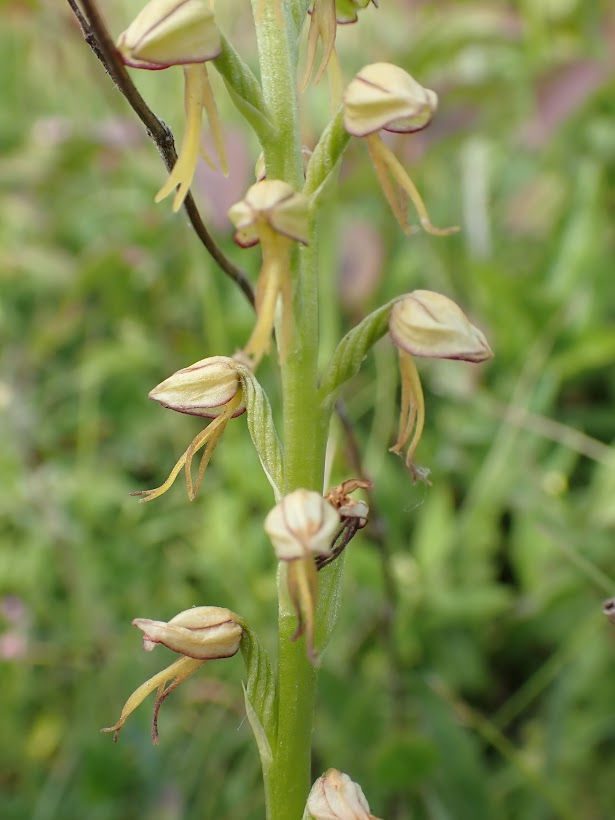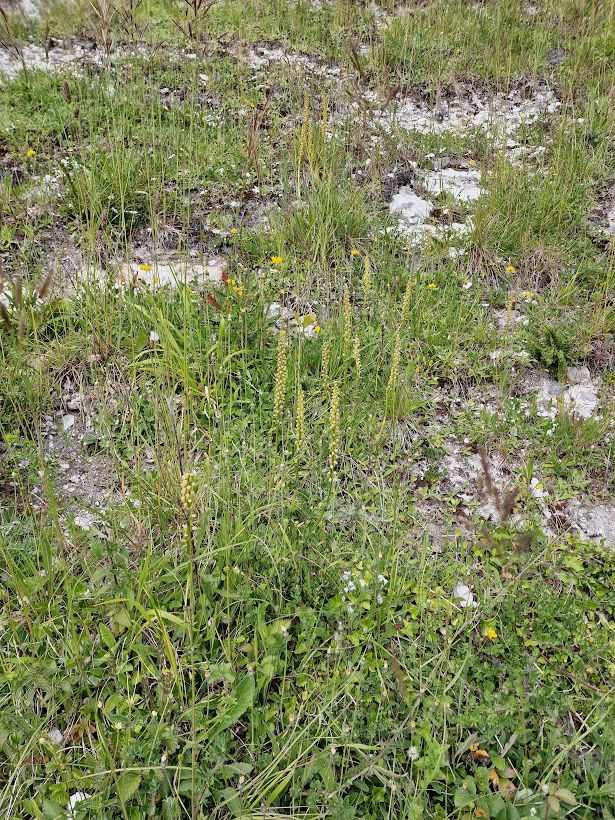Burnt Tip Orchids, Sussex & Man Orchids, Darland Banks, Kent. 06 & 07.06.23
- Sim Elliott

- Jun 8, 2023
- 4 min read
I saw Burnt Tip Orchids in Sussex. I am not going to reveal where they were as last year there were some thefts of them. When I saw them last year, I saw about 10 plants, this year I only saw two. The Man Orchids I saw at Kent Wildlife Trust's Darland Banks. Sweeping panoramic views are not what you expect to find in the heart of the Medway towns but this site has long defied convention. This is our most diverse reserve which is home to the largest population of Man Orchids in the country. Darland Banks | Kent Wildlife Trust
I got to Darland by catching trains from Brighton to Gillingham (changing at London Victoria); a two-hour train trip. From Gillingham Station. It then a 45 minute walk from Gillingham Station to Darland Banks. I walked down Nelson Road from the Station; then crossed the A2, The Roman Wattling Street, and walked down Ash Tree Lane to Darland Banks
Map: Google Maps

The photographs are presented chronologically
All sections of text in italics are quotations, sources sited.
I am only an amateur naturalist; thus all identifications are provisional; if you note a mistake in identification please feel free to tell me. If you want to contact me about any aspect of this blog, email me at simeon[underscore]elliott[at]gmail[dot]com.
Burnt Tip Orchids - South Downs, Sussex


Botanical Society Of Britain and Ireland Plant Atlas 2020 Neotinea ustulata (L.) R.M.Bateman, Pridgeon & M.W.Chase in BSBI Online Plant Atlas 2020

Pyramid Orchard - white form

Darland Banks, Gillingham
Some of our rarest and most threatened species thrive on this restored chalk grassland just a stone’s throw from one of Kent’s biggest conurbations - Straw belle moth, Small blue butterfly, Yellowhammer and Roman snail to name but a few.
Human history has played its part in creating the diversity. Large blocks of concrete from an anti-aircraft gun emplacement provides shelter for reptiles, backfilled WWII practise trenches are filled with Man Orchids, Red star thistle established here when it was used by people with horse drawn wagons and each year a different vegetable pops up in the most recently cleared areas. Darland Banks | Kent Wildlife Trust
View from the downs above Darland Banks

Adonis Blue


Man Orchids, Orchis anthropophora,
The Man Orchid is one of our rarest orchids and is classified as endangered under Schedule 8 of the Wildlife and Countryside Act. Its presence is now confined to a few protected reserves and sites around England, and the numbers are still in decline. It is particularly vulnerable to agricultural pollution and runoff but scrub encroachment is also a problem. As its name suggests the flowers of Orchis anthropophora resemble a tiny hooded figure making it relatively easy to identify although the drab greenish colour makes it difficult to spot. The flowers are often tinged with dark brownish-red and less often with yellow. It is sometimes confused with the Frog Orchid Dactylorhiza viridis (which is a much smaller plant) and Common Twayblade Neottia ovata (easily distinguished by the two large oval basal leaves). The Man Orchid grows in a number of habitats including sand dunes, roadside verges and downland, but all are chalk-based. Orchis anthropophora: identification, distribution, pictures (hardyorchidsociety.org.uk)

Neottia ovata, Common twayblade, from Wolstonbury Hill, East Sussex - for comparison

Path through the reserve - looking north



Bladder Campion

Yellow Rattle

Pyramid Orchid

Man Orchids



Birds Foot Trefoil

Man Orchids



Copestone Heights from Darland Bank

Environmental mitigation or green washing?

Man Orchids





White Dead Nettle

Man Orchids


On the chalk banks of Ash Tree Lane


Hairy Shield Bug on Man Orchid









Kidney Vetch



Common Dogwood

Kentish Snail




Lichens and Bryophytes on the concrete bollards of Ash Tree Lane
For lichens & bryophytes, concrete is more of a home than the chalk downland of butterflies/orchids. These concrete bollards in provide a home for Grimmia pulvinata & Xanothoria parietina. When you don't need soil & other plants to live, the world is your oyster.


Grimmia pulvinata Grey Grimmia

Xanothoria parietina, Common Orange Lichen

Watling Street, Roman road ... that ran from Dover west-northwest to London and thence northwest via St. Albans (Verulamium) to Wroxeter (Ouirokónion, or Viroconium). It was one of Britain’s greatest arterial roads of the Roman and post-Roman periods. The name came from a group of Anglo-Saxon settlers who called Verulamium by the name of Wætlingaceaster. This local name passed to the whole of the Roman road (Wæclinga stræt) by the 9th century. Watling Street | Roman road, United Kingdom | Britannica

Located on the corner of Watling Street and Beechwood Avenue on the Chatham-Gillingham border. The Palace Cinema was built by a subsidiary of the Gaumont British Theatres chain, and opened on 30th November 1936. It was a ‘sister’ theatre to the larger Majestic Cinema Rochester, which had opened a year earlier.
The exterior had a tall square clock tower, which was outlined in neon at night. Inside the auditorium seating was located on stalls and circle levels. Interior decorations were by noted interior designers Mollo & Egan. The proscenium was 42 feet wide and the stage was 20 feet deep. There were seven dressing rooms. The Palace Cinema was equipped with a Compton 3Manual/7Ranks organ which was opened by organist Terence Casey. There was a café/ballroom in the building, and a large car park opposite the entrance.
The Palace Cinema was re-named Gaumont from 18th December 1950, and usually play films concurrent with the Gaumont (ex-Majestic Cinema) Rochester. The Gaumont was closed by the Rank Organisation on 2nd February 1961 with John Gregson in "The Captain’s Table". It was converted into a 24-lane Top Rank Bowling Alley, which opened in December 1961. Eventually, this was the last of the Top Rank Bowls to close, closing on 31st October 1970.
The building was converted into a B&Q hardware store, and the interior has been gutted. It was later in use as a camping centre, which remains open in 2010 as Camping International. The building is now known as Clock Tower House. Gaumont Chatham in Gillingham, GB - Cinema Treasures




Gillingham - Poverty
I think it would be wrong not to acknowledge the obvious crushing poverty in the area in which the beautiful Man Orchards are located. We need to protect nature but we need to lift the poor out of poverty in the Medway area, and everywhere else.
Child poverty in the Gillingham and Rainham constituency is at 31% as of 2019, up 2% from 2015 and according to ONS data, unemployment levels are also higher in Gillingham compared to the national average. The town also has a high level of residents with either no qualifications or qualifications equal to one.
Such levels of deprivation lead to profound challenges, whether that be homelessness, health impacts or crime.
Councillor Naushabah Khan, Gillingham South ward. Medway: Left behind by 'levelling up' - Progressive Britain






Comments